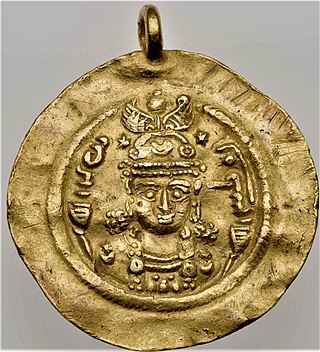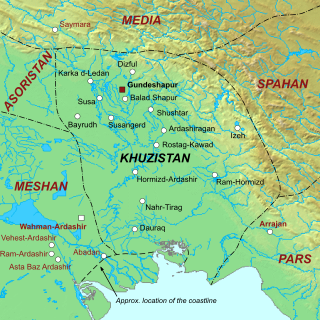
Hormizd-Ardashir, better known by his dynastic name of Hormizd I, was the third Sasanian King of Kings (shahanshah) of Iran, who ruled from May 270 to June 271. He was the third-born son of Shapur I, under whom he was governor-king of Armenia, and also took part in his father's wars against the Roman Empire. Hormizd I's brief time as ruler of Iran was largely uneventful. He built the city of Hormizd-Ardashir, which remains a major city today in Iran. He promoted the Zoroastrian priest Kartir to the rank of chief priest (mowbed) and gave the Manichaean prophet Mani permission to continue his preaching.

Yazdegerd III was the last Sasanian King of Kings of Iran from 632 to 651. His father was Shahriyar and his grandfather was Khosrow II.

The Muslim conquest of Persia, also known as the Arab conquest of Iran, was carried out by the Rashidun Caliphate from 632 to 654 and led to the fall of the Sasanian Empire, as well as the eventual decline of the Zoroastrian religion.

Boran was Sasanian queen (banbishn) of Iran from 630 to 632, with an interruption of some months. She was the daughter of king Khosrow II and the Byzantine princess Maria. She is the second of only three women to rule in Iranian history, the others being Musa of Parthia, and Boran's sister Azarmidokht.

The Battle of Nahavand, also spelled Nihavand or Nahawand, was fought in 642 between the Rashidun Muslim forces under caliph Umar and Sasanian Persian armies under King Yazdegerd III. Yazdegerd escaped to the Merv area, but was unable to raise another substantial army. It was a victory for the Rashidun Caliphate and the Persians consequently lost the surrounding cities including Spahan (Isfahan).

Sakastan was a Sasanian province in Late Antiquity, that lay within the kust of Nemroz. The province bordered Kirman in the west, Spahan in the north west, Kushanshahr in the north east, and Turan in the south east. The governor of the province held the title of marzban. The governor also held the title of "Sakanshah" until the title was abolished in ca. 459/60.

Hormuzan was a Persian aristocrat who served as the governor of Khuzestan, and was one of the Sasanian military officers at the Battle of al-Qādisiyyah. He was later taken prisoner by the Muslims after the fall of Shushtar in 642. Two years later, he was accused of the assassination of the Rashidun caliph Umar, and was killed by Ubayd Allah, the deceased caliph's son.
Farrukhzad was an Iranian aristocrat from the House of Ispahbudhan and the founder of the Bavand dynasty, ruling from 651 to 665. Originally a powerful servant of the Sasanian king Khosrow II, he, along with several other powerful aristocrats made a conspiracy against the latter and ended his tyrannical rule. They thereafter put Khosrow's son Kavadh II on the throne, whose rule lasted only a few months, before he was killed by a plague, being succeeded by his son Ardashir III, who was only after one year murdered by the rebellious former Sasanian army chief (spahbed) Shahrbaraz, who usurped the throne.

Arfajah ibn Harthama al-Bariqi was a companion of prophet Muhammad. He was a member of the Azd branch of the Bariq clan that inhabited Southwestern Arabia.
Siyavakhsh was an Iranian aristocrat from the House of Mihran who was descended from Bahram Chobin, the famous spahbed of the Sasanian Empire.
Piruz Khosrow, also known as Piruzan or Firuzan, was a powerful Persian aristocrat who was the leader of the Parsig (Persian) faction that controlled much of the affairs of the Sasanian Empire during the Sasanian civil war of 628-632. He was killed at the Battle of Nahāvand in 642.
The Sasanian civil war of 628–632, also known as the Sasanian Interregnum was a conflict that broke out after the execution of the Sasanian king Khosrow II between the nobles of different factions, notably the Parthian (Pahlav) faction, the Persian (Parsig) faction, the Nimruzi faction, and the faction of general Shahrbaraz. Rapid turnover of rulers and increasing provincial landholder power further diminished the empire. Over a period of four years and 14 successive kings, the Sasanian Empire weakened considerably, and the power of the central authority passed into the hands of its generals, contributing to its fall.
Mihran-i Bahram-i Razi, better simply known as Mihran Razi, was an Iranian military officer from the Mihran family. He was killed in 637 at the battle of Jalula.
The Battle of Waj Rudh was fought in 642/643 between the Rashidun Caliphate under Nu'man, and the Sasanian Empire under the Dailamite Muta, the Parthian Farrukhzad and Isfandiyar, and the Armenian Varaztirots. The battle was fought in Waj Rudh, a village in Hamadan. The location was precisely theorized and occurred on a road junction between Hamadan and Qazvin.

The siege of Shushtar was fought from 641 to 642 between the Sasanian Empire and the invading Arab Muslims of the Rashidun Caliphate. Shushtar was an ancient strong stronghold in Khuzestan, and was attacked by the Arabs under their commander Abu Musa Ashaari. Although the city managed to resist the Arabs, the Sasanians later faced desertion, which resulted in the Arabs capturing the city and capturing its commander, Hormuzan.
The siege of Gundishapur took place in 642. It was the last major city in Khuzestan to fall to the Arabs. According to al-Tabari and al-Baladhuri, the Arab general Abu Musa Ashaari marched to Gundishapur and besieged the city. The cities defences were weak and after a few days the city surrendered and opened its gate. Abu Musa then made peace with the city in return for tribute, which the city accepted. However, some inhabitants of the city refused to live under the rule of the Rashidun Caliphate, and fled to Kalbaniyah. Abu Musa then went to the city and easily seized it. He thereafter seized a few other small cities, thus completing the conquest of Khuzestan.
The Asawira were a military unit of the Rashidun and Umayyad Caliphate. The unit consisted of Iranian noblemen who were originally part of the aswaran unit of the Sasanian army. It was disbanded in 703 by al-Hajjaj ibn Yusuf.
Siyah, known in Arabic sources as Siyah al-Uswari was an Iranian nobleman, who served as the commander of a faction of the Sasanian asbaran unit, but later defected to the Rashidun Caliphate, where he continued serving as the commander of the asbaran.

Pars was a Sasanian province in Late Antiquity, which almost corresponded to the present-day province of Fars. The province bordered Khuzestan in the west, Kirman in the east, Spahan in the north, and Mazun in the south.

Khuzistan or Huzistan was a Sasanian province in Late Antiquity, which almost corresponded to the present-day province of Khuzestan. Its capital was Gundeshapur. During the late Sasanian era, the province was included in the southern quadrant (kust) of Nemroz.












